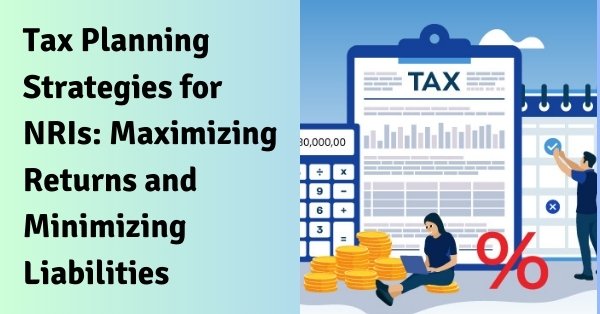How to Plan for Your Children’s Education as an NRI?
If you’re an NRI (Non-Resident Indian), making sure your children get a good education is probably one of your biggest money goals. Schools are getting more expensive everywhere, so you need a good plan to pay for your kids’ education without money worries. This guide will show you how to save and invest wisely for your children’s future studies, whether in India or another country. What Does Education Cost These Days? Before you start saving, you should know how much money you’ll need. You’ll have to pay for things like: Studying in India In India, professional courses like engineering, medicine, and business management aren’t cheap: Studying in Other Countries If you’re thinking about sending your kids to places like America, Britain, Canada, or Australia, be ready to spend more. You might need $30,000-$60,000 every year for fees and living costs. How to Plan for Your Kid’s Education 1. Start Saving Early The sooner you start saving, the better. Your money has more time to grow, and you’ll need to save less each month. Here’s what you can do: 2. Spread Your Money Around Don’t put all your eggs in one basket. Invest in different things: 3. Think About Money Exchange Rates If your child studies abroad, changes in exchange rates can affect your savings. Protect yourself by: 4. Keep Education Loans as Plan B While it’s best to save up, education loans can help if needed. Banks often give good deals to NRIs, covering: 5. Look for Free Money (Scholarships) Many schools give scholarships to good students. This can really help cut down your costs. Look for scholarships in: Where Can NRIs Put Their Money? 1. Special NRI Bank Accounts You can open two types of accounts: 2. Investment Funds and Bonds You can put money in: 3. Property Buying property in India can be smart because: Conclusion As an NRI, planning for your kids’ education needs careful thinking. Start saving early, put your money in different places, and understand all the costs. With good planning and the right money tools, you can make sure your children get the education they deserve without money stress. FAQs’ 10.Why split money between different investments?Ans- It makes your savings safer and helps you get better returns over time. Disclaimer: The information provided here is for educational and informational purposes only and should not be construed as financial, legal, or tax advice. Consult with a qualified professional before making any investment decisions. We do not accept any liability for errors or omissions in this information nor any direct, indirect, or consequential losses arising from its use.
Tax Planning Strategies for NRIs: Maximizing Returns and Minimizing Liabilities
As a Non-Resident Indian (NRI), navigating the complex landscape of tax planning can be a daunting task. With obligations to both your country of residence and India, it’s crucial to employ effective strategies that optimize your financial position. This comprehensive guide will explore various tax planning approaches for NRIs, helping you maximize returns while minimizing tax liabilities. Understanding NRI Tax Status Before delving into specific strategies, it’s essential to understand what constitutes an NRI status for tax purposes. According to the Income Tax Act of India, an individual is considered an NRI if they reside outside India for 182 days or more during a financial year. This status significantly impacts your tax obligations and available planning opportunities. Income Source Considerations For NRIs, the source of income plays a crucial role in determining tax liability. Income earned or accrued outside India is generally not taxable in India. However, income generated within India or received in India is subject to taxation. This distinction forms the foundation of many tax planning strategies for NRIs. Leveraging Double Taxation Avoidance Agreements (DTAAs) India has signed DTAAs with numerous countries to prevent the same income from being taxed twice. As an NRI, you can take advantage of these agreements to optimize your tax position. By carefully structuring your investments and income sources, you can potentially reduce your overall tax burden across both countries. It’s important to note that the specifics of DTAAs vary between countries. Familiarize yourself with the agreement between India and your country of residence to identify potential benefits and plan accordingly. Strategic Investment Planning Investments form a cornerstone of effective tax planning for NRIs. By choosing the right investment vehicles, you can not only grow your wealth but also manage your tax liabilities efficiently. Non-Resident External (NRE) and Non-Resident Ordinary (NRO) Accounts: NRE accounts offer significant tax advantages, as the interest earned is tax-free in India. Additionally, funds in NRE accounts are fully repatriable. On the other hand, while interest earned on NRO accounts is taxable, these accounts allow you to manage income generated within India. Tax-Efficient Mutual Funds: Consider investing in growth-oriented mutual funds rather than dividend-paying ones. Capital gains from the sale of mutual fund units are typically taxed at lower rates compared to dividend income. Real Estate Investments: While real estate can be an attractive investment option, be aware of the tax implications. Rental income from properties in India is taxable, but you can claim deductions for expenses like property tax and maintenance. If you sell a property, understand the capital gains tax rules and explore options like reinvestment to defer taxes. Fixed Deposits and Bonds: Interest from fixed deposits is taxable for NRIs. However, certain bonds, like infrastructure bonds, may offer tax benefits. Research thoroughly to find options that align with your financial goals and tax situation. Retirement Planning Strategies Planning for retirement as an NRI requires a nuanced approach to balance tax efficiency with long-term financial security. National Pension System (NPS): The NPS offers tax benefits and can be an excellent tool for retirement planning. Contributions to NPS Tier-1 accounts are eligible for tax deductions, and the corpus is partially tax-free at maturity. Provident Fund Accounts: If you have an existing Employees’ Provident Fund (EPF) account in India, you can continue to maintain it as an NRI. The interest earned is tax-free, making it an attractive long-term savings option. Optimizing Remittances Carefully plan your remittances to India to maximize tax efficiency. Utilize the Liberalized Remittance Scheme (LRS) wisely, which allows NRIs to remit up to USD 250,000 per financial year for various purposes, including investments and gifts to relatives. Tax-Efficient Gifting: Gifts to close relatives in India can be an effective way to transfer wealth while potentially reducing your tax liability. However, be aware of gift tax implications for the recipient in India. Charitable Donations: Consider making donations to registered charitable organizations in India. These contributions can often be claimed as deductions, reducing your taxable income. Professional Assistance and Regular Review Given the complexities of international taxation and the frequent changes in tax laws, seeking professional advice is crucial. Consult with tax experts who specialize in NRI taxation to ensure you’re leveraging all available opportunities and complying with relevant regulations. Regular review and adjustment of your tax planning strategies are essential. As your financial situation evolves and tax laws change, your approach may need to be refined to remain optimal. Conclusion Effective tax planning for NRIs involves a multifaceted approach that considers various investment vehicles, retirement planning tools, and strategic financial decisions. By understanding your NRI status, leveraging DTAAs, making informed investment choices, and seeking professional guidance, you can create a robust tax planning strategy that maximizes your returns while minimizing liabilities. Remember, while tax efficiency is important, it should not be the sole driver of your financial decisions. Always balance tax considerations with your overall financial goals, risk tolerance, and long-term objectives. FAQs: Disclaimer: The information provided here is for educational and informational purposes only and should not be construed as financial, legal, or tax advice. Consult with a qualified professional before making any investment decisions. We do not accept any liability for errors or omissions in this information nor any direct, indirect, or consequential losses arising from its use.
Education Options for NRI Children Returning to India: Schools and Colleges
As Non-Resident Indian (NRI) families consider returning to India, one of the most important factors to consider is the education of their children. The Indian education system offers a wide range of options for returning NRI children, from international schools to traditional Indian institutions. This guide will help you understand the various educational pathways available for your children when moving back to India. International Schools International schools in India offer curricula that are globally recognized, making them a popular choice for NRI families. These schools typically follow one of these international curriculum, International Baccalaureate (IB), Cambridge International Examinations (CIE), or American curriculum. Benefits of international schools include: However, these schools often have higher fees compared to other options. You may like to read this: The Best International Schools in India for Returning NRIs Indian Curriculum Schools India has several national and state boards that offer quality education: Central Board of Secondary Education (CBSE), Indian Certificate of Secondary Education (ICSE), State Boards These schools offer: The curriculum might be challenging for children who are not fluent in Hindi or the local language. For families looking for non-traditional approaches, India offers alternative education options such as: Montessori schools, Waldorf schools, and Open schooling through the National Institute of Open Schooling (NIOS) These schools provide flexible learning environments and can be suitable for children who need to catch up on the Indian curriculum or prefer non-conventional teaching methods. College Education Options India has numerous prestigious universities offering a wide range of courses: Delhi University, Mumbai University, Bangalore University, etc. These universities offer: India’s premier institutes are known for their excellent education and high employment rates: Indian Institutes of Technology (IITs), Indian Institutes of Management (IIMs), All India Institute of Medical Sciences (AIIMS) Admission to these institutes is highly competitive and often requires clearing tough entrance exams. Private Universities Private universities in India often offer more flexibility and modern facilities: Manipal University, BITS Pilani, Ashoka University These universities may have: However, they generally have higher fees compared to government institutions. Some foreign universities have campuses or partnerships in India, offering international degrees: Georgia Institute of Technology (partnership with IIT Bombay), Lancaster University (campus in Gurgaon) These provide international education without leaving India but can be expensive. Preparing for the Transition Conclusion Returning to India offers NRI children a unique opportunity to experience India’s rich cultural heritage while receiving quality education. Whether you choose an international school, an Indian curriculum school, or a premier college, the key is to find an institution that best fits your child’s needs and aspirations. With proper research and preparation, your child can have a smooth transition into the Indian education system and set the foundation for a bright future. Disclaimer: The information provided here is for educational and informational purposes only and should not be construed as financial, legal, or tax advice. Consult with a qualified professional before making any investment decisions. We do not accept any liability for errors or omissions in this information nor any direct, indirect, or consequential losses arising from its use.
The Best International Schools in India for Returning NRIs
For Non-Resident Indians (NRIs) planning to return to India, one of the most important considerations is finding the right school for their children. International schools in India offer a global curriculum, multicultural environment, and modern facilities that can ease the transition for children studying abroad. This guide will help you understand the international school landscape in India and highlight some of the best options across major cities. Why Choose an International School? International schools in India offer several advantages for returning NRI families: • Global Curriculum: Most international schools follow internationally recognized curricula like IB, IGCSE, or American systems. • English-Medium Instruction: These schools primarily use English as the medium of instruction. • Multicultural Environment: Students interact with peers from diverse backgrounds. • Modern Facilities: Many international schools boast state-of-the-art infrastructure and resources. • Extracurricular Activities: A wide range of sports and cultural activities are usually offered. Top International Schools in Major Indian Cities Delhi NCR 1. The British School, New Delhi • Curriculum: IB and IGCSE • Known for its strong academic program and diverse student body Visit website: https://www.british-school.org/ 2. American Embassy School, New Delhi • Curriculum: American • Offers Advanced Placement (AP) courses and has excellent facilities Visit website: https://www.aes.ac.in/ 3. Pathways World School, Gurgaon • Curriculum: IB • Boasts a sprawling campus and focuses on holistic development Visit website: https://www.pws.edu.in/ Mumbai 1. Dhirubhai Ambani International School • Curriculum: IB, IGCSE, and ISC • Known for its world-class facilities and high academic standards Visit website: https://www.dais.edu.in/ 2. Oberoi International School • Curriculum: IB • Offers a strong emphasis on sports and performing arts Visit website: https://www.oberoi-is.org/ 3. American School of Bombay • Curriculum: American • Features excellent technology integration in education Visit website: https://www.asbindia.org/ Bangalore 1. Indus International School • Curriculum: IB and IGCSE • Known for its leadership program and sports facilities Visit website: https://indusschool.com/ 2. Canadian International School • Curriculum: IB • Offers a diverse, multicultural environment Visit website: https://www.canadianinternationalschool.com/ 3. Stonehill International School • Curriculum: IB • Located on a large campus with excellent boarding facilities Visit website: https://www.stonehill.in/ Chennai 1. American International School Chennai • Curriculum: American and IB • Known for its strong science and technology programs Visit website: https://www.aischennai.org/ 2. Hebron School, Ooty • Curriculum: Cambridge IGCSE and A Levels • Offers a unique boarding school experience in the Nilgiri Hills Visit website: https://www.hebronooty.org/ Pune 1. Mercedes-Benz International School • Curriculum: IB • Known for its strong German language program and ties to the automotive industry Visit website: https://www.mbis.org/ 2. Victorious Kidss Educares • Curriculum: IB • Focuses on a holistic approach to education Visit website: https://victoriouskidsseducares.org/ Factors to Consider When Choosing a School When selecting an international school for your child, consider the following factors: 1. Curriculum: Ensure the curriculum aligns with your child’s previous education and future goals. 2. Accreditation: Look for schools accredited by recognized international education bodies. 3. Faculty: Research the qualifications and experience of the teaching staff. 4. Facilities: Visit the campus to assess the quality of classrooms, labs, sports facilities, and libraries. 5. Location: Consider the distance from your home and transportation options. 6. Extracurricular Activities: Look for schools that offer a range of activities that match your child’s interests. 7. Student-Teacher Ratio: Smaller class sizes often mean more individual attention for students. 8. Diversity: A mix of international and local students can provide a rich cultural experience. 9. University Placements: For older students, consider the school’s track record in college admissions. 10. Fee Structure: International schools can be expensive, so factor in the costs and any additional fees. Admission Process The admission process for international schools in India typically involves the following steps: 1. Application submission (often online) 2. Entrance tests (usually for English and Math) 3. Previous academic records review 4. Student and parent interviews 5. Payment of registration and admission fees Many schools have waiting lists, so it’s advisable to apply well in advance. Preparing Your Child for the Transition To help your child adjust to their new school in India: • Discuss the move openly and address any concerns they may have. • If possible, visit the school before the term starts to familiarize your child with the environment. • Encourage your child to participate in orientation programs and extracurricular activities to make new friends. • Stay in regular communication with teachers to monitor your child’s progress and address any issues early. Conclusion- Choosing the right international school can significantly impact your child’s education and overall experience when returning to India. While this list provides an overview of some top schools, it’s essential to research thoroughly, visit the campuses, and speak with current parents and students if possible. Every child is unique, and what works best for one may not be ideal for another. Take your time to find a school that aligns with your family’s values and your child’s needs to ensure a smooth transition and a positive educational experience in India.Disclaimer: The information provided here is for educational and informational purposes only and should not be construed as financial, legal, or tax advice. Consult with a qualified professional before making any investment decisions. We do not accept any liability for errors or omissions in this information nor any direct, indirect, or consequential losses arising from its use.





